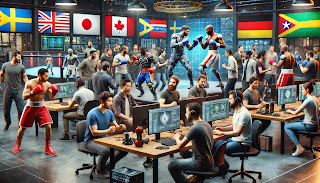To create the most realistic boxing video game, the best hires should come from various parts of the world, depending on their expertise in different areas of game development, combat sports, and technology. Here’s a deep dive into the ideal global talent pool based on industry strengths:
1. Game Development & Simulation Physics
United Kingdom (UK) & Canada
- Why? The UK and Canada have some of the best simulation-based game development studios.
- Notable Studios & Talent Pools:
- Codemasters (UK) – Experts in physics-based racing games like F1 and Dirt, which require high-level physics accuracy.
- Criterion Games (UK) – Known for their destruction physics in Burnout and Need for Speed.
- Ubisoft Toronto (Canada) – Specializes in motion capture and physics-based gameplay.
- How This Helps: A realistic boxing game needs accurate physics, fluid movement, and punch impact variations, and these studios have deep experience in that.
2. Combat Sports AI & Behavior
Japan & France
- Why? Japan and France have long-standing experience in creating AI-driven sports and combat systems.
- Notable Contributions:
- SEGA AM2 (Japan) – Created the Virtua Fighter series, known for its realistic fighting AI and physics.
- EKO Software (France) – Developed UFC Throwdown, one of the earliest realistic MMA games with AI-driven combat behavior.
- How This Helps: Japan and France could provide AI developers who specialize in opponent tendencies, defensive mechanics, and strategic AI-based decision-making for realistic boxing gameplay.
3. Motion Capture & Fighter Animation
United States (California & New York) & Sweden
- Why? The US and Sweden have world-class motion capture studios that work with top-tier fighters and athletes.
- Notable Studios & Expertise:
- EA Sports (Vancouver, Canada & Orlando, USA) – EA’s FIFA and UFC games have some of the best mocap in sports.
- Rockstar San Diego (USA) – Created Red Dead Redemption 2, which features hyper-realistic character animations.
- DICE (Sweden) – Known for Battlefield’s hyper-realistic character movement and fluid animations.
- How This Helps: High-quality motion capture and animation blending are crucial for realistic punch mechanics, defense movement, and knockdowns in a boxing game.
4. Realistic Boxer Models & Graphics
South Korea & Germany
- Why? These countries lead in hyper-realistic character modeling and rendering.
- Notable Contributions:
- South Korea (Nexon & NCSoft) – Specializes in ultra-detailed character models (e.g., Black Desert Online).
- Crytek (Germany) – Created CryEngine, one of the most visually stunning game engines (Crysis series).
- How This Helps: South Korea and Germany could provide photorealistic boxer models, skin textures, lighting, and sweat simulation.
5. Realistic Sound Design (Punches, Crowds, Commentary)
United States & Australia
- Why? US and Australian sound designers have experience with real-world sports commentary, crowd dynamics, and punch impact sounds.
- Notable Studios & Expertise:
- Skywalker Sound (USA) – Worked on major movies and games, specializing in realistic sound effects.
- Firelight Technologies (Australia) – Developed FMOD, a leading sound engine used in games.
- How This Helps: The right team from these countries could create authentic punch impact sounds, realistic breathing, and immersive arena atmosphere.
6. Realistic Fighting Strategy & Boxer Tendencies
Cuba, Mexico, United States, UK, & Ukraine
- Why? These countries have a deep understanding of different boxing styles and training methods.
- Boxing Influence:
- Cuba – Mastery of technical, defensive, and Olympic-style boxing.
- Mexico – Aggressive, body-punching, come-forward styles.
- United States – Balanced styles across all weight classes.
- UK – Strong heavyweight and technical fighters.
- Ukraine – Advanced footwork (e.g., Lomachenko, Usyk).
- How This Helps: Hiring real boxing trainers, cutmen, and analysts from these regions would ensure authentic boxer tendencies and training mechanics.
7. Online Multiplayer & Netcode
South Korea & United States
- Why? South Korea leads in online multiplayer stability, and the US has major online gaming infrastructure.
- Notable Contributions:
- South Korea (Bluehole, Nexon, NCSoft) – Experts in high-speed, low-lag online gaming.
- United States (Activision, Riot Games, Epic Games) – Specializes in large-scale online netcode.
- How This Helps: A great online multiplayer experience requires low-latency netcode and smooth matchmaking.
Conclusion
To create the most realistic boxing video game, a company should pull talent from:
- UK & Canada – Simulation physics, gameplay mechanics.
- Japan & France – AI behavior, combat strategy.
- United States & Sweden – Motion capture, realistic animations.
- South Korea & Germany – Visual fidelity, character rendering.
- United States & Australia – Sound design and arena atmosphere.
- Cuba, Mexico, UK, Ukraine, USA – Boxing strategy, real-life tendencies.
- South Korea & USA – Multiplayer netcode for online play.
By combining these global talents, a true-to-life boxing simulation could be achieved, setting a new standard for realism in boxing video games.


.jpg)




